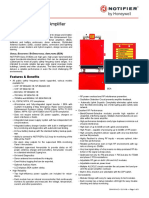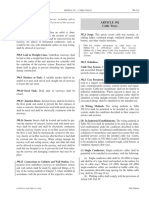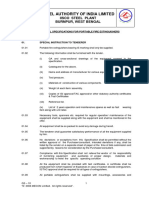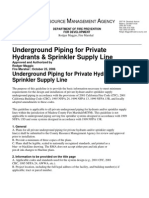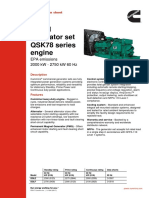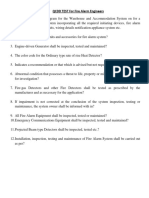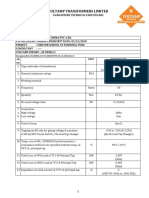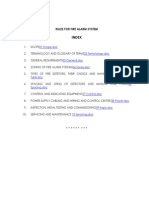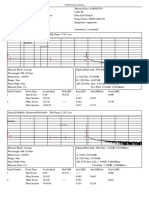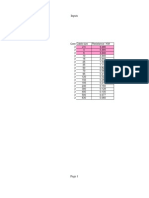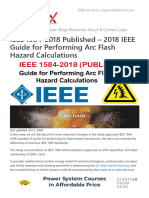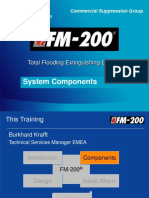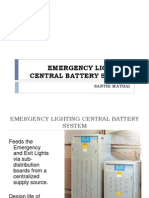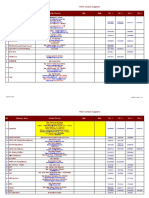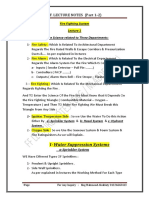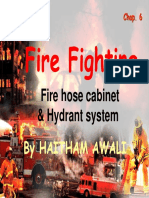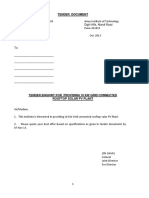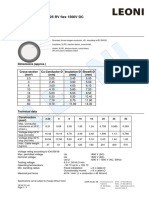Fire Alarm Systems (From NEC)
Fire Alarm Systems (From NEC)
Uploaded by
mostafaabdelrazikCopyright:
Available Formats
Fire Alarm Systems (From NEC)
Fire Alarm Systems (From NEC)
Uploaded by
mostafaabdelrazikCopyright
Available Formats
Share this document
Did you find this document useful?
Is this content inappropriate?
Copyright:
Available Formats
Fire Alarm Systems (From NEC)
Fire Alarm Systems (From NEC)
Uploaded by
mostafaabdelrazikCopyright:
Available Formats
727.
3 Article 760 — Fire Alarm Systems
727.3 Other Articles Exception No. 2: Where a metallic sheath or armor is ap-
In addition to the provisions of this article, installation of plied over the nonmetallic sheath of the Type ITC cable.
Type ITC cable shall comply with other applicable articles
of this Code, such as Articles 240, 250, 300, and 392. 727.6 Construction
The insulated conductors of Type ITC cable shall be in sizes
727.4 Uses Permitted 22 AWG through 12 AWG. The conductor material shall be
Type ITC cable shall be permitted to be used as follows in copper or thermocouple alloy. Insulation on the conductors
industrial establishments where the conditions of mainte- shall be rated for 300 volts. Shielding shall be permitted.
nance and supervision ensure that only qualified persons The cable shall be listed as being resistant to the spread
service the installation: of fire. The outer jacket shall be sunlight and moisture resis-
tant.
(1) In cable trays. Where a smooth metallic sheath, continuous corrugated
(2) In raceways. metallic sheath, or interlocking tape armor is applied over
(3) In hazardous locations as permitted in 501.10, 502.10, the nonmetallic sheath, an overall nonmetallic jacket shall
503.10, 504.20, 504.30, 504.80, and 505.15. not be required.
(4) Enclosed in a smooth metallic sheath, continuous corru-
gated metallic sheath, or interlocking tape armor applied 727.7 Marking
over the nonmetallic sheath in accordance with 727.6. The cable shall be marked in accordance with 310.11(A)(2),
The cable shall be supported and secured at intervals (A)(3), (A)(4), and (A)(5). Voltage ratings shall not be
not exceeding 1.8 m (6 ft). marked on the cable.
(5) Without a metallic sheath or armor between cable tray
and equipment in lengths not to exceed 15 m (50 ft), 727.8 Allowable Ampacity
where the cable is supported and protected against phys-
ical damage using mechanical protection, such as struts, The allowable ampacity of the conductors shall be 5 amperes,
angles, or channels. The cable shall be supported and except for 22 AWG conductors, which shall have an allow-
secured at intervals not exceeding 1.8 m (6 ft). able ampacity of 3 amperes.
(6) Between cable tray and equipment in lengths not to
exceed 15 m (50 ft), where the cable complies with the 727.9 Overcurrent Protection
crush and impact requirements of Type MC cable and Overcurrent protection shall not exceed 5 amperes for 20
is identified for such use. The cable shall be supported AWG and larger conductors, and 3 amperes for 22 AWG
and secured at intervals not exceeding 1.8 m (6 ft). conductors.
(7) As aerial cable on a messenger.
(8) Direct buried where identified for the use. 727.10 Bends
(9) Under raised floors in rooms containing industrial proc- Bends in Type ITC cables shall be made so as not to damage
ess control equipment and rack rooms where arranged the cable.
to prevent damage to the cable.
(10) Under raised floors in information technology equip-
ment rooms in accordance with 645.5(D)(5)(c). ARTICLE 760
727.5 Uses Not Permitted
Fire Alarm Systems
Type ITC cable shall not be installed on circuits operating
at more than 150 volts or more than 5 amperes. Summary of Changes
Installation of Type ITC cable with other cables shall • 760.8: Revised requirement covering mechanical execu-
be subject to the stated provisions of the specific articles tion of work.
for the other cables. Where the governing articles do not • 760.21: Revised to prohibit arc-fault circuit interrupters
contain stated provisions for installation with Type ITC (AFCIs) in addition to GFCIs in the supply circuit for the
cable, the installation of Type ITC cable with the other cables power source of non–power-limited fire alarm circuits.
shall not be permitted.
• 760.30(B)(2), (B)(3), and (B)(4): Added new Exception
Type ITC cable shall not be installed with power, light-
No. 3 permitting circuit integrity (CI) cable.
ing, Class 1, or non–power-limited circuits.
• 760.41: Revised to prohibit arc-fault circuit interrupters
Exception No. 1: Where terminated within equipment or (AFCIs) in addition to GFCIs in the supply circuit for the
junction boxes and separations are maintained by insulating power source of power-limited fire alarm circuits.
barriers or other means.
1098 2005 National Electrical Code Handbook
--`,,,``,-`-`,,`,,`,`,,`---
Copyright National Fire Protection Association
Provided by IHS under license with NFPA
No reproduction or networking permitted without license from IHS Not for Resale
Article 760 — Fire Alarm Systems 727.10
• 760.52: Revised to permit combinations of 760.52(A) and 760.30 Multiconductor NPLFA Cables
(B) wiring methods on load side of PLFA power source. (A) NPLFA Wiring Method
• 760.56(D): Added new requirement prohibiting audio sys- (B) Applications of Listed NPLFA Cables
tem circuits using Class 2 or Class 3 conductors and PLFA III. Power-Limited Fire Alarm (PLFA) Circuits
circuits in the same raceway. 760.41 Power Sources for PLFA Circuits
(A) Transformers
• 760.61(A), (B)(1), and (C): Revised to permit circuit (B) Power Supplies
integrity (CI) cable. (C) Listed Equipment
• 760.81(F) and 760.82(G): Added new requirements for 760.42 Circuit Marking
NPLFA and PLFA circuit integrity (CI) cable. 760.51 Wiring Methods on Supply Side of the PLFA
Power Source
760.52 Wiring Methods and Materials on Load Side of
Contents the PLFA Power Source
(A) NPLFA Wiring Methods and Materials
I. General (B) PLFA Wiring Methods and Materials
760.1 Scope 760.54 Installation of Conductors and Equipment in
760.2 Definitions Cables, Compartments, Cable Trays,
760.3 Other Articles Enclosures, Manholes, Outlet Boxes, Device
(A) Spread of Fire or Products of Combustion Boxes, and Raceways for Power-Limited
(B) Ducts, Plenums, and Other Air-Handling Spaces Circuits
(C) Hazardous (Classified) Locations 760.55 Separation from Electric Light, Power, Class 1,
(D) Corrosive, Damp, or Wet Locations NPLFA, and Medium Power Network-Powered
(E) Building Control Circuits Broadband Communications Circuit
(F) Optical Fiber Cables Conductors
760.7 Access to Electrical Equipment Behind Panels (A) General
Designed to Allow Access (B) Separated by Barriers
760.8 Mechanical Execution of Work (C) Raceways Within Enclosures
760.9 Fire Alarm Circuit and Equipment Grounding (D) Associated Systems Within Enclosures
760.10 Fire Alarm Circuit Identification (E) Enclosures with Single Opening
760.11 Fire Alarm Circuits Extending Beyond One (F) In Hoistways
Building (G) Other Applications
760.15 Fire Alarm Circuit Requirements 760.56 Installation of Conductors of Different PLFA
(A) Non–Power-Limited Fire Alarm (NPLFA) Circuits, Class 2, Class 3, and Communications
Circuits Circuits in the Same Cable, Enclosure, or
(B) Power-Limited Fire Alarm (PLFA) Circuits Raceway
II. Non–Power-Limited Fire Alarm (NPLFA) Circuits (A) Two or More PLFA Circuits
760.21 NPLFA Circuit Power Source Requirements (B) Class 2 Circuits with PLFA Circuits
760.23 NPLFA Circuit Overcurrent Protection (C) Low-Power Network-Powered Broadband
760.24 NPLFA Circuit Overcurrent Device Location Communications Cables and PLFA Cables
760.25 NPLFA Circuit Wiring Methods (D) Audio System Circuits and PLFA Circuits
760.26 Conductors of Different Circuits in Same Cable, 760.57 Conductor Size
Enclosure, or Raceway 760.58 Support of Conductors
(A) Class 1 with NPLFA Circuits 760.59 Current-Carrying Continuous Line-Type Fire
(B) Fire Alarm with Power-Supply Circuits Detectors
760.27 NPLFA Circuit Conductors (A) Application
(A) Sizes and Use (B) Installation
(B) Insulation 760.61 Applications of Listed PLFA Cables
(C) Conductor Materials (A) Plenum
760.28 Number of Conductors in Cable Trays and (B) Riser
Raceways, and Derating (C) Other Wiring Within Buildings
(A) NPLFA Circuits and Class 1 Circuits (D) Fire Alarm Cable Substitutions
(B) Power-Supply Conductors and Fire Alarm IV. Listing Requirements
Circuit Conductors 760.81 Listing and Marking of NPLFA Cables
(C) Cable Trays (A) NPLFA Conductor Materials
National Electrical Code Handbook 2005 --`,,,``,-`-`,,`,,`,`,,`--- 1099
Copyright National Fire Protection Association
Provided by IHS under license with NFPA
No reproduction or networking permitted without license from IHS Not for Resale
760.1 Article 760 — Fire Alarm Systems
(B) Insulated Conductors an occupancy is required to have a fire alarm system is
(C) Type NPLFP found in NFPA 101威, Life Safety Code威, or other local codes.
(D) Type NPLFR Examples of fire alarm devices and equipment are
(E) Type NPLF shown in Exhibits 760.1 and 760.2. The installation of these
(F) Fire Alarm Circuit Integrity (CI) Cable or system components is covered by NFPA 72, but the circuit
Electrical Circuit Protective System wiring associated with these components must be installed
(G) NPLFA Cable Markings in accordance with the requirements of Article 760. Single-
760.82 Listing and Marking of PLFA Cables and and multiple-station smoke alarms, such as those commonly
Insulated Continuous Line-Type Fire Detectors installed in dwelling units, are supplied through 120-volt
(A) Conductor Materials branch circuits rather than through a non–power-limited or
(B) Conductor Size power-limited fire alarm signaling circuit that is powered
(C) Ratings and controlled by a fire alarm control panel. Branch circuits
(D) Type FPLP supplying power to single- and multiple-station smoke
(E) Type FPLR alarms are not subject to the requirements of Article 760.
(F) Type FPL NFPA 72 requires that all wiring, cable, and equipment
(G) Fire Alarm Circuit Integrity (CI) Cable or be in accordance with NFPA 70, National Electrical Code威,
Electrical Circuit Protective System and specifically with Article 760. Additionally, NFPA 72
(H) Coaxial Cables requires all equipment to be listed for its intended purpose.
(I) Cable Marking NFPA 1221, Standard for the Installation, Maintenance,
(J) Insulated Continuous Line-Type Fire Detectors and Use of Emergency Services Communications Systems,
covers the installation, maintenance, and use of all public
fire service communications facilities. These facilities in-
I. General
760.1 Scope
This article covers the installation of wiring and equipment
of fire alarm systems including all circuits controlled and
powered by the fire alarm system.
FPN No. 1: Fire alarm systems include fire detection
and alarm notification, guard’s tour, sprinkler waterflow,
and sprinkler supervisory systems. Circuits controlled
and powered by the fire alarm system include circuits for
the control of building systems safety functions, elevator
capture, elevator shutdown, door release, smoke doors
and damper control, fire doors and damper control and
fan shutdown, but only where these circuits are powered
by and controlled by the fire alarm system. For further
information on the installation and monitoring for integ-
rity requirements for fire alarm systems, refer to the
NFPA 72威-2002, National Fire Alarm Code威.
FPN No. 2: Class 1, 2, and 3 circuits are defined in
Article 725.
--`,,,``,-`-`,,`,,`,`,,`---
Article 760 covers only those circuits that are powered and
controlled by the fire alarm system, including fire safety
features such as smoke door control, damper control, fan
shutdown, and elevator recall. Circuits powered and con-
trolled by other building systems such as heating, ventilating,
and air conditioning (HVAC); security; lighting controls;
and time recording are covered by Article 725.
Article 760 covers the wiring between the devices and
equipment required by NFPA 72威, National Fire Alarm
Code威. NFPA 72 provides the requirements for the selection,
installation, performance, use, and testing and maintenance
of fire alarm system components. The provision for whether Exhibit 760.1 Typical fire alarm control unit.
1100 2005 National Electrical Code Handbook
Copyright National Fire Protection Association
Provided by IHS under license with NFPA
No reproduction or networking permitted without license from IHS Not for Resale
Article 760 — Fire Alarm Systems 760.7
760.3 Other Articles
Circuits and equipment shall comply with 760.3(A) through
760.3(F). Only those sections of Article 300 referenced in
this article shall apply to fire alarm systems.
(A) Spread of Fire or Products of Combustion Section
300.21. The accessible portion of abandoned fire alarm ca-
bles shall be removed.
(B) Ducts, Plenums, and Other Air-Handling Spaces
Section 300.22, where installed in ducts or plenums or other
spaces used for environmental air.
Exception: As permitted in 760.30(B)(1) and (B)(2) and
760.61(A).
See the commentary following 300.22(B) and 300.22(C) for
Exhibit 760.2 Typical spot-type smoke detector. more information on wiring installed in ducts, plenums, or
other spaces used for environmental air.
clude public reporting, dispatching, telephone, and two-way
and microwave radio systems, all of which fulfill two princi-
pal functions: the receipt of fire alarms or other emergency (C) Hazardous (Classified) Locations Articles 500
calls from the public and the retransmission of these alarms through 516 and Article 517, Part IV, where installed in
and emergency calls to fire companies and other appropriate hazardous (classified) locations.
agencies.
(D) Corrosive, Damp, or Wet Locations Sections 110.11,
760.2 Definitions 300.6, and 310.9 where installed in corrosive, damp, or wet
locations.
Abandoned Fire Alarm Cable. Installed fire alarm cable
that is not terminated at equipment other than a connector
and not identified for future use with a tag. Section 760.3(D) requires cables and equipment that are
used in wet or damp locations, high ambient temperature
areas, or corrosive locations to be identified as suitable for
This definition was added to the 2002 Code for use with the particular use. Underground installations are considered
760.3(A), which requires removal of accessible abandoned wet locations.
fire alarm cable. Abandoned cable increases fire loading
unnecessarily, and, where installed in plenums, it can affect
airflow. Similar requirements can be found in Articles 640, (E) Building Control Circuits Article 725 where building
645, 725, 770, 800, 820, and 830. control circuits (e.g., elevator capture, fan shutdown) are
associated with the fire alarm system.
Fire Alarm Circuit. The portion of the wiring system be-
tween the load side of the overcurrent device or the power- (F) Optical Fiber Cables Where optical fiber cables are
limited supply and the connected equipment of all circuits utilized for fire alarm circuits, the cables shall be installed
powered and controlled by the fire alarm system. Fire alarm in accordance with Article 770.
circuits are classified as either non–power-limited or power-
limited. 760.7 Access to Electrical Equipment Behind
Panels Designed to Allow Access
Fire Alarm Circuit Integrity (CI) Cable. Cable used in
fire alarm systems to ensure continued operation of critical Access to electrical equipment shall not be denied by an
circuits during a specified time under fire conditions. accumulation of conductors and cables that prevents removal
of panels, including suspended ceiling panels.
Non–Power-Limited Fire Alarm Circuit (NPLFA). A fire
alarm circuit powered by a source that complies with 760.21
and 760.23. An excess accumulation of wires and cables can limit access
to equipment by preventing the removal of access panels.
Power-Limited Fire Alarm Circuit (PLFA). A fire alarm See Exhibit 760.3.
circuit powered by a source that complies with 760.41.
National Electrical Code Handbook 2005 1101
--`,,,``,-`-`,,`,,`,`,,`---
Copyright National Fire Protection Association
Provided by IHS under license with NFPA
No reproduction or networking permitted without license from IHS Not for Resale
760.8 Article 760 — Fire Alarm Systems
760.9 Fire Alarm Circuit and
Equipment Grounding
Fire alarm circuits and equipment shall be grounded in accor-
dance with Article 250.
Fire
Hung ceiling alarm
cavity cables
760.10 Fire Alarm Circuit Identification
Fire alarm circuits shall be identified at terminal and junction
locations in a manner that will prevent unintentional interfer-
Method Not Permitted
ence with the signaling circuit during testing and servicing.
760.11 Fire Alarm Circuits Extending Beyond
One Building
Power-limited fire alarm circuits that extend beyond one
building and run outdoors either shall meet the installation
Fire alarm
requirements of Parts II, III, and IV of Article 800 or shall
Hung ceiling meet the installation requirements of Part I of Article 300.
cables
cavity
Non–power-limited fire alarm circuits that extend beyond
one building and run outdoors shall meet the installation
Permitted Method requirements of Part I of Article 300 and the applicable
sections of Part I of Article 225.
Exhibit 760.3 Incorrect installation of conductors and cables
(upper diagram), which can prevent access to equipment or 760.15 Fire Alarm Circuit Requirements
cables. Correct method is shown in lower diagram. Fire alarm circuits shall comply with 760.15(A) and
760.15(B).
(A) Non–Power-Limited Fire Alarm (NPLFA) Circuits
760.8 Mechanical Execution of Work
See Parts I and II.
Fire alarm circuits shall be installed in a neat workmanlike
manner. Cables and conductors installed exposed on the (B) Power-Limited Fire Alarm (PLFA) Circuits See
surface of ceilings and sidewalls shall be supported by the Parts I and III.
building structure in such a manner that the cable will not
be damaged by normal building use. Such cables shall be Exact power source limitations for power-limited fire alarm
supported by straps, staples, hangers, or similar fittings de- circuits used by testing laboratories are found in Chapter 9,
signed and installed so as not to damage the cable. The Table 12(A) and Table 12(B). Table 12(A) covers alternating-
installation shall also conform with 300.4(D). current source limitations, and Table 12(B) covers direct-
current source limitations.
FPN: One source of information describing industry
practices is ANCI/NECA 305-2001, Standard for Fire
Alarm System Job Practice. II. Non–Power-Limited Fire Alarm
(NPLFA) Circuits
This section provides definitive requirements for workman-
760.21 NPLFA Circuit Power
ship. Cable must be attached to or supported by the structure
by straps, clamps, hangers, and the like. The installation
Source Requirements
method must not damage the cable. In addition, the location The power source of non–power-limited fire alarm circuits
of the cable should be carefully evaluated to ensure that shall comply with Chapters 1 through 4, and the output
activities and processes within the building do not cause voltage shall not be more than 600 volts, nominal. These
damage to the cable. circuits shall not be supplied through ground-fault circuit
The reference to 300.4(D) calls attention to the hazards interrupters or arc-fault circuit interrupters.
to which cables are exposed where they are installed on FPN: See 210.8(A)(5), Exception No. 3, for receptacles
framing members. Such cables are required to be installed in dwelling-unit unfinished basements that supply power
in a manner that protects them from nail or screw penetration. for fire alarm systems.
In the 2005 Code, there was a change to this section to
permit attachment to baseboards and non–load bearing walls, Section 760.21 was revised for the 2005 Code. It prohibits
which are not structural components. supplying a non–power-limited fire alarm circuit through a
1102 2005 National Electrical Code Handbook
--`,,,``,-`-`,,`,,`,`,,`---
Copyright National Fire Protection Association
Provided by IHS under license with NFPA
No reproduction or networking permitted without license from IHS Not for Resale
Article 760 — Fire Alarm Systems 760.26
ground-fault circuit interrupter or an arc-fault circuit inter- ered to be protected by overcurrent protection on the input
rupter. The intent is to supply a fire alarm system through of the electronic power source.
a source that is not subject to interruption. This requirement FPN: A single-phase, listed electronic power supply
does not apply to single- or multiple-station smoke alarms. whose output supplies a 2-wire (single-voltage) circuit
Single- and multiple-station smoke alarms are not supplied is an example of a non–power-limited power source that
through a non–power-limited fire alarm circuit. Smoke meets the requirements of 760.21.
alarms in new construction are required by NFPA 72威, Na-
tional Fire Alarm Code威, to have a backup battery that will Non–power-limited electronic power supplies that do not
supply power in the event that the branch circuit power is supply energy directly through the use of transformers are
interrupted due to the operation of a GFCI or AFCI device. covered by Exception No. 3 to 760.24, which permits over-
current protection for the non–power-limited circuit conduc-
tors to be installed on the input side of the electronic power
760.23 NPLFA Circuit Overcurrent Protection source rather than on the output side for 2-wire circuits only.
Overcurrent protection for conductors 14 AWG and larger
shall be provided in accordance with the conductor ampacity
without applying the derating factors of 310.15 to the ampac-
760.25 NPLFA Circuit Wiring Methods
ity calculation. Overcurrent protection shall not exceed 7 Installation of non–power-limited fire alarm circuits shall
amperes for 18 AWG conductors and 10 amperes for 16 be in accordance with 110.3(B), 300.11, 300.15, 300.17, and
AWG conductors. other appropriate articles of Chapter 3.
Exception: Where other articles of this Code permit or re- Exception No. 1: As provided in 760.26 through 760.30.
quire other overcurrent protection. Exception No. 2: Where other articles of this Code require
other methods.
760.24 NPLFA Circuit Overcurrent
Device Location Section 760.25 requires that the appropriate wiring methods
Overcurrent devices shall be located at the point where the in Chapter 3 be used for non–power-limited circuits. How-
conductor to be protected receives its supply. ever, 760.25, Exception No. 1, permits special non–power-
limited cable types to be used in place of Chapter 3 wiring
Exception No. 1: Where the overcurrent device protecting methods.
the larger conductor also protects the smaller conductor. Section 760.25 requires that devices be mounted in ac-
Exception No. 2: Transformer secondary conductors. cordance with Chapter 3. Section 300.11(A) requires devices
Non–power-limited fire alarm circuit conductors supplied and equipment to be securely mounted. Section 300.15(B)
by the secondary of a single-phase transformer that has only is referenced to require non–power-limited circuit termina-
a 2-wire (single-voltage) secondary shall be permitted to be tions to be made in a box or conduit body. However,
protected by overcurrent protection provided by the primary 300.15(E) permits devices with integral terminal enclosures
(supply) side of the transformer, provided the protection is and mounting brackets to be used without a box. Devices
in accordance with 450.3 and does not exceed the value must be mounted on a box or conduit body where the instruc-
determined by multiplying the secondary conductor ampac- tions or listing require the use of a box. Fire alarm system
ity by the secondary-to-primary transformer voltage ratio. components such as manual fire alarm boxes are frequently
Transformer secondary conductors other than 2-wire shall tested. Therefore, secure mounting of the back box is neces-
not be considered to be protected by the primary overcurrent sary to ensure that the manual fire alarm device will remain
protection. in place. (See Exhibit 760.4.)
Exception No. 3: Electronic power source output conduc-
tors. Non–power-limited circuit conductors supplied by the 760.26 Conductors of Different Circuits in Same
output of a single-phase, listed electronic power source, Cable, Enclosure, or Raceway
other than a transformer, having only a 2-wire (single-
(A) Class 1 with NPLFA Circuits Class 1 and non–power-
voltage) output for connection to non–power-limited circuits
limited fire alarm circuits shall be permitted to occupy the
shall be permitted to be protected by overcurrent protection
same cable, enclosure, or raceway without regard to whether
provided on the input side of the electronic power source,
the individual circuits are alternating current or direct cur-
provided this protection does not exceed the value deter-
rent, provided all conductors are insulated for the maximum
mined by multiplying the non–power-limited circuit conduc-
voltage of any conductor in the enclosure or raceway.
tor ampacity by the output-to-input voltage ratio. Electronic
--`,,,``,-`-`,,`,,`,`,,`---
power source outputs, other than 2-wire (single voltage), (B) Fire Alarm with Power-Supply Circuits Power-
connected to non–power-limited circuits shall not be consid- supply and fire alarm circuit conductors shall be permitted
National Electrical Code Handbook 2005 1103
Copyright National Fire Protection Association
Provided by IHS under license with NFPA
No reproduction or networking permitted without license from IHS Not for Resale
760.27 Article 760 — Fire Alarm Systems
be Type KF-2, KFF-2, PAFF, PTFF, PF, PFF, PGF, PGFF,
RFH-2, RFHH-2, RFHH-3, SF-2, SFF-2, TF, TFF, TFN,
TFFN, ZF, or ZFF. Conductors with other types and thickness
of insulation shall be permitted if listed for non–power-
limited fire alarm circuit use.
FPN: For application provisions, see Table 402.3.
(C) Conductor Materials Conductors shall be solid or
stranded copper.
Exception to (B) and (C): Wire Types PAF and PTF shall
be permitted only for high-temperature applications between
90⬚C (194⬚F) and 250⬚C (482⬚F).
760.28 Number of Conductors in Cable Trays
and Raceways, and Derating
(A) NPLFA Circuits and Class 1 Circuits Where only
non–power-limited fire alarm circuit and Class 1 circuit
conductors are in a raceway, the number of conductors shall
be determined in accordance with 300.17. The derating fac-
Exhibit 760.4 Typical manual fire alarm box.
tors given in 310.15(B)(2)(a) shall apply if such conductors
carry continuous load in excess of 10 percent of the ampacity
in the same cable, enclosure, or raceway only where con- of each conductor.
nected to the same equipment.
(B) Power-Supply Conductors and Fire Alarm Circuit
760.27 NPLFA Circuit Conductors Conductors Where power-supply conductors and fire alarm
(A) Sizes and Use Only copper conductors shall be permit- circuit conductors are permitted in a raceway in accordance
ted to be used for fire alarm systems. Size 18 AWG and 16 with 760.26, the number of conductors shall be determined
AWG conductors shall be permitted to be used, provided in accordance with 300.17. The derating factors given in
they supply loads that do not exceed the ampacities given 310.15(B)(2)(a) shall apply as follows:
in Table 402.5 and are installed in a raceway, an approved (1) To all conductors where the fire alarm circuit conductors
enclosure, or a listed cable. Conductors larger than 16 AWG carry continuous loads in excess of 10 percent of the
shall not supply loads greater than the ampacities given in ampacity of each conductor and where the total number
310.15, as applicable. of conductors is more than three
(2) To the power-supply conductors only, where the fire
The minimum size of conductors permitted to be used on alarm circuit conductors do not carry continuous loads
non–power-limited fire protective signaling circuits is 18 in excess of 10 percent of the ampacity of each conduc-
AWG. The load must not exceed the conductor ampacities tor and where the number of power-supply conductors
specified in Table 402.5. is more than three
NFPA 72, National Fire Alarm Code, requires fire alarm
device and appliance voltages to be between 85 and 110 (C) Cable Trays Where fire alarm circuit conductors are
percent of nominal rated voltage. Calculations should be installed in cable trays, they shall comply with 392.9 through
made to ensure that all devices or appliances will be op- 392.11.
erating within these limits at full circuit load. Where future
circuit extensions are anticipated, larger conductors should 760.30 Multiconductor NPLFA Cables
be considered. Some manufacturers specify maximum cir- Multiconductor non–power-limited fire alarm cables that
cuit loop resistances. The equipment specifications should meet the requirements of 760.81 shall be permitted to be
be consulted to ensure that maximum allowable loop resist- used on fire alarm circuits operating at 150 volts or less
ances are not exceeded. and shall be installed in accordance with 760.30(A) and
760.30(B).
(B) Insulation Insulation on conductors shall be suitable (A) NPLFA Wiring Method Multiconductor non–power-
for 600 volts. Conductors larger than 16 AWG shall comply limited fire alarm circuit cables shall be installed in accor-
with Article 310. Conductors 18 AWG and 16 AWG shall dance with 760.30(A)(1), (A)(2), and (A)(3).
1104 2005 National Electrical Code Handbook
--`,,,``,-`-`,,`,,`,`,,`---
Copyright National Fire Protection Association
Provided by IHS under license with NFPA
No reproduction or networking permitted without license from IHS Not for Resale
Article 760 — Fire Alarm Systems 760.41
(1) Exposed or Fished in Concealed Spaces In raceway pended ceilings used as an environmental air-handling return
or exposed on surface of ceiling and sidewalls or fished in are considered by the Code as ‘‘other spaces used for envi-
concealed spaces. Cable splices or terminations shall be ronmental air.’’ Non–power-limited cables used in other
made in listed fittings, boxes, enclosures, fire alarm devices, spaces used for environmental air must, however, be marked
or utilization equipment. Where installed exposed, cables NPLFP. [See 760.81(C).]
shall be adequately supported and installed in such a way that
maximum protection against physical damage is afforded
by building construction such as baseboards, door frames, Exception No. 3: Type NPLFP-CI cable shall be permitted
ledges, and so forth. Where located within 2.1 m (7 ft) of to be installed to provide a 2-hour circuit integrity rated
the floor, cables shall be securely fastened in an approved cable.
manner at intervals of not more than 450 mm (18 in.).
(3) Riser Cables installed in vertical runs and penetrating
(2) Passing Through a Floor or Wall In metal raceway more than one floor or cables installed in vertical runs in a
or rigid nonmetallic conduit where passing through a floor shaft shall be Type NPLFR. Floor penetrations requiring
or wall to a height of 2.1 m (7 ft) above the floor unless Type NPLFR shall contain only cables suitable for riser or
adequate protection can be afforded by building construction plenum use.
such as detailed in 760.30(A)(1) or unless an equivalent
solid guard is provided. Exception No. 1: Type NPLF or other cables that are speci-
fied in Chapter 3 and are in compliance with 760.27(C) and
(3) In Hoistways In rigid metal conduit, rigid nonmetallic encased in metal raceway.
conduit, intermediate metal conduit, liquidtight flexible non-
metallic conduit, or electrical metallic tubing where installed Exception No. 2: Type NPLF cables located in a fireproof
in hoistways. shaft having firestops at each floor.
Exception: As provided for in 620.21 for elevators and simi- FPN: See 300.21 for firestop requirements for floor pen-
lar equipment. etrations.
(B) Applications of Listed NPLFA Cables The use of Exception No. 3: Type NPLFR-CI cable shall be permitted
non–power-limited fire alarm circuit cables shall comply to be installed to provide a 2-hour circuit integrity rated
with 760.30(B)(1) through (B)(4). cable.
(1) Ducts and Plenums Multiconductor non–power- (4) Other Wiring Within Buildings Cables installed in
limited fire alarm circuit cables, Types NPLFP, NPLFR, and building locations other than the locations covered in
NPLF, shall not be installed exposed in ducts or plenums. 760.30(B)(1), (B)(2), and (B)(3) shall be Type NPLF.
Exception No. 1: Chapter 3 wiring methods with conductors
Wiring methods for non–power-limited circuits in ducts and in compliance with 760.27(C).
plenums must be in accordance with the Chapter 3 wiring
methods covered by 300.22(B). It is important to note that Exception No. 2: Type NPLFP or Type NPLFR cables shall
cables marked NPLFP may not be installed in plenums. be permitted.
While the ‘‘P’’ designation was used for consistency, the Exception No. 3: Type NPLF-CI cable shall be permitted
higher possible voltages and currents of non–power-limited to be installed to provide a 2-hour circuit integrity rated
fire alarm circuits preclude the use of the listed cables inside cable.
plenums.
III. Power-Limited Fire Alarm
FPN: See 300.22(B). (PLFA) Circuits
(2) Other Spaces Used for Environmental Air Cables 760.41 Power Sources for PLFA Circuits
installed in other spaces used for environmental air shall be
Type NPLFP. The power source for a power-limited fire alarm circuit shall
be as specified in 760.41(A), (B), or (C). These circuits shall
Exception No. 1: Types NPLFR and NPLF cables installed not be supplied through ground-fault circuit interrupters or
in compliance with 300.22(C). arc-fault circuit interrupters.
Exception No. 2: Other wiring methods in accordance with
300.22(C) and conductors in compliance with 760.27(C). FPN No. 1: Tables 12(A) and 12(B) in Chapter 9 provide
the listing requirements for power-limited fire alarm cir-
cuit sources.
Other spaces used for environmental air are covered by FPN No. 2: See 210.8(A)(5), Exception No. 3, for recep-
300.22(C) and the related fine print note. Spaces over sus- tacles in dwelling-unit unfinished basements that supply
--`,,,``,-`-`,,`,,`,`,,`---
power for fire alarm systems.
National Electrical Code Handbook 2005 1105
Copyright National Fire Protection Association
Provided by IHS under license with NFPA
No reproduction or networking permitted without license from IHS Not for Resale
760.42 Article 760 — Fire Alarm Systems
(A) Transformers A listed PLFA or Class 3 transformer. Also note the information contained in the fine print note
that follows 760.52(A), Exception No. 3, regarding circuit
(B) Power Supplies A listed PLFA or Class 3 power classification.
supply.
(C) Listed Equipment Listed equipment marked to iden-
tify the PLFA power source. (A) NPLFA Wiring Methods and Materials Installation
shall be in accordance with 760.25, and conductors shall be
FPN: Examples of listed equipment are a fire alarm con- solid or stranded copper.
trol panel with integral power source; a circuit card listed
for use as a PLFA source, where used as part of a listed
assembly; a current-limiting impedance, listed for the Section 760.52(A) requires power-limited fire alarm circuits
purpose or part of a listed product, used in conjunction using non–power-limited fire alarm wiring methods and ma-
with a non–power-limited transformer or a stored energy terials to be installed in accordance with 760.25. Section
source, for example, storage battery, to limit the output
760.25 requires that non–power-limited devices be mounted
current.
in accordance with Chapter 3. Section 300.11(A) requires
760.42 Circuit Marking these devices and equipment to be securely mounted. Section
300.15(B) is also referenced to require non–power-limited
The equipment supplying PLFA circuits shall be durably circuit terminations to be made in a box or conduit body.
marked where plainly visible to indicate each circuit that is However, 300.15(E) permits devices with integral terminal
a power-limited fire alarm circuit. enclosures and mounting brackets to be used without a box.
FPN: See 760.52(A), Exception No. 3, where a power- Devices are required to be mounted on a box or conduit
limited circuit is to be reclassified as a non–power-limited body where the instructions or listing indicates the use of a
circuit. box. Fire alarm system components such as manual fire
alarm boxes are frequently tested. Secure mounting is neces-
760.51 Wiring Methods on Supply Side of the sary to ensure that they will remain in place.
PLFA Power Source
Conductors and equipment on the supply side of the power
source shall be installed in accordance with the appropriate Exception No. 1: The derating factors given in
requirements of Part II and Chapters 1 through 4. Transform- 310.15(B)(2)(a) shall not apply.
ers or other devices supplied from power-supply conductors Exception No. 2: Conductors and multiconductor cables
shall be protected by an overcurrent device rated not over described in and installed in accordance with 760.27 and
20 amperes. 760.30 shall be permitted.
Exception: The input leads of a transformer or other power Exception No. 3: Power-limited circuits shall be permitted
source supplying power-limited fire alarm circuits shall be to be reclassified and installed as non–power-limited circuits
permitted to be smaller than 14 AWG, but not smaller than if the power-limited fire alarm circuit markings required by
18 AWG, if they are not over 300 mm (12 in.) long and if 760.42 are eliminated and the entire circuit is installed using
they have insulation that complies with 760.27(B). the wiring methods and materials in accordance with Part
II, Non–Power-Limited Fire Alarm Circuits.
760.52 Wiring Methods and Materials on Load
Side of the PLFA Power Source FPN: Power-limited circuits reclassified and installed as
non–power-limited circuits are no longer power-limited
Fire alarm circuits on the load side of the power source circuits, regardless of the continued connection to a
shall be permitted to be installed using wiring methods and power-limited source.
materials in accordance with 760.52(A), 760.52(B), or a
combination of (A) and (B). Section 760.52(A) permits any of the wiring methods in
Chapter 3 to be used for power-limited circuits. In addition,
Section 760.52 has been revised for the 2005 Code. It now 760.52(A), Exception No. 3, allows power-limited circuits
permits individual power-limited circuits to be installed to be reclassified and installed in accordance with the re-
using Chapter 3 wiring methods, non–power-limited fire quirements for non–power-limited circuits. Where installed
alarm circuit wiring methods, power-limited circuit wiring as non–power-limited circuits, the power-limited marking
methods, or a combination. If it is desirable to run power- must be removed from equipment, overcurrent protection
limited circuits in the same cable or raceway with must be provided in accordance with 760.23, and reclassified
non–power-limited circuits, the power-limited circuits may circuits must maintain separation from power-limited cir-
be reclassified as permitted by 760.52(A), Exception No. 3. cuits, in accordance with 760.26 and 760.54.
1106 2005 National Electrical Code Handbook
--`,,,``,-`-`,,`,,`,`,,`---
Copyright National Fire Protection Association
Provided by IHS under license with NFPA
No reproduction or networking permitted without license from IHS Not for Resale
Article 760 — Fire Alarm Systems 760.55
(B) PLFA Wiring Methods and Materials Power-limited compartment, enclosure, manhole, outlet box, device box,
fire alarm conductors and cables described in 760.82 shall raceway, or similar fitting with conductors of electric light,
be installed as detailed in 760.52(B)(1), (B)(2), or (B)(3) of power, Class 1, non–power-limited fire alarm circuits, and
this section. Devices shall be installed in accordance with medium power network-powered broadband communica-
110.3(B), 300.11(A), and 300.15. tions circuits unless permitted by 760.55(B) through
760.55(G).
Section 760.52(B) requires mechanical protection at splices
and termination points. Because failure of a circuit often Jackets of listed power-limited fire alarm cables do not have
occurs at splices or termination points, this requirement of- sufficient construction specifications to permit them to be
fers more protection and strain relief for these cable connec- installed with electric light, power, Class 1, non–power-
tions. limited fire alarm circuits, and medium power network-
powered broadband communications cables. Failure of the
cable insulation due to a fault could lead to hazardous volt-
(1) Exposed or Fished in Concealed Spaces In raceway
--`,,,``,-`-`,,`,,`,`,,`---
ages being imposed on the power-limited fire alarm circuit
or exposed on the surface of ceiling and sidewalls or fished conductors.
in concealed spaces. Cable splices or terminations shall be
made in listed fittings, boxes, enclosures, fire alarm devices,
or utilization equipment. Where installed exposed, cables (B) Separated by Barriers Power-limited fire alarm cir-
shall be adequately supported and installed in such a way that cuit cables shall be permitted to be installed together with
maximum protection against physical damage is afforded Class 1, non–power-limited fire alarm, and medium power
by building construction such as baseboards, door frames, network-powered broadband communications circuits where
ledges, and so forth. Where located within 2.1 m (7 ft) of they are separated by a barrier.
the floor, cables shall be securely fastened in an approved
manner at intervals of not more than 450 mm (18 in.). (C) Raceways Within Enclosures In enclosures, power-
limited fire alarm circuits shall be permitted to be installed
(2) Passing Through a Floor or Wall In metal raceways
in a raceway within the enclosure to separate them from
or rigid nonmetallic conduit where passing through a floor
Class 1, non–power-limited fire alarm, and medium power
or wall to a height of 2.1 m (7 ft) above the floor, unless
network-powered broadband communications circuits.
adequate protection can be afforded by building construction
such as detailed in 760.52(B)(1) or unless an equivalent (D) Associated Systems Within Enclosures Power-
solid guard is provided. limited fire alarm conductors in compartments, enclosures,
(3) In Hoistways In rigid metal conduit, rigid nonmetallic device boxes, outlet boxes, or similar fittings shall be permit-
conduit, intermediate metal conduit, or electrical metallic ted to be installed with electric light, power, Class 1,
tubing where installed in hoistways. non–power-limited fire alarm, and medium power network-
powered broadband communications circuits where they are
Exception: As provided for in 620.21 for elevators and simi- introduced solely to connect the equipment connected to
lar equipment. power-limited fire alarm circuits, and comply with either of
the following conditions:
760.54 Installation of Conductors and
Equipment in Cables, Compartments, Cable (1) The electric light, power, Class 1, non–power-limited
Trays, Enclosures, Manholes, Outlet Boxes, fire alarm, and medium power network-powered broad-
band communications circuit conductors are routed to
Device Boxes, and Raceways for
maintain a minimum of 6 mm (0.25 in.) separation from
Power-Limited Circuits the conductors and cables of power-limited fire alarm
Conductors and equipment for power-limited fire alarm cir- circuits.
cuits shall be installed in accordance with 760.55 through (2) The circuit conductors operate at 150 volts or less to
760.58. ground and also comply with one of the following:
a. The fire alarm power-limited circuits are installed
760.55 Separation from Electric Light, Power,
using Type FPL, FPLR, FPLP, or permitted substitute
Class 1, NPLFA, and Medium Power Network- cables, provided these power-limited cable conduc-
Powered Broadband Communications tors extending beyond the jacket are separated by a
Circuit Conductors minimum of 6 mm (0.25 in.) or by a nonconductive
(A) General Power-limited fire alarm circuit cables and sleeve or nonconductive barrier from all other con-
conductors shall not be placed in any cable, cable tray, ductors.
National Electrical Code Handbook 2005 1107
Copyright National Fire Protection Association
Provided by IHS under license with NFPA
No reproduction or networking permitted without license from IHS Not for Resale
760.56 Article 760 — Fire Alarm Systems
b. The power-limited fire alarm circuit conductors are cations circuits, or Class 3 circuits shall be permitted within
installed as non–power-limited circuits in accordance the same cable, enclosure, or raceway.
with 760.25.
(B) Class 2 Circuits with PLFA Circuits Conductors of
(E) Enclosures with Single Opening Power-limited fire one or more Class 2 circuits shall be permitted within the
alarm circuit conductors entering compartments, enclosures, same cable, enclosure, or raceway with conductors of power-
device boxes, outlet boxes, or similar fittings shall be permit- limited fire alarm circuits, provided that the insulation of
ted to be installed with electric light, power, Class 1, the Class 2 circuit conductors in the cable, enclosure, or
non–power-limited fire alarm, and medium power network- raceway is at least that required by the power-limited fire
powered broadband communications circuits where they are alarm circuits.
introduced solely to connect the equipment connected to
power-limited fire alarm circuits or to other circuits con- (C) Low-Power Network-Powered Broadband Commu-
trolled by the fire alarm system to which the other conductors nications Cables and PLFA Cables Low-power network-
in the enclosure are connected. Where power-limited fire powered broadband communications circuits shall be per-
alarm circuit conductors must enter an enclosure that is mitted in the same enclosure or raceway with PLFA cables.
provided with a single opening, they shall be permitted to
enter through a single fitting (such as a tee), provided the (D) Audio System Circuits and PLFA Circuits Audio
conductors are separated from the conductors of the other system circuits described in 640.9(C) and installed using
circuits by a continuous and firmly fixed nonconductor, such Class 2 or Class 3 wiring methods in compliance with 725.54
as flexible tubing. and 725.61 shall not be permitted to be installed in the same
cable or raceway with power-limited conductors or cables.
(F) In Hoistways In hoistways, power-limited fire alarm
circuit conductors shall be installed in rigid metal conduit, Section 760.56(D) is new in the 2005 Code. This section
rigid nonmetallic conduit, intermediate metal conduit, liq- prohibits audio circuits that are installed as Class 2 or Class
uidtight flexible nonmetallic conduit, or electrical metallic 3 circuits from being installed in the same cable or raceway
tubing. For elevators or similar equipment, these conductors with power-limited fire alarm wiring. A fault between audio
shall be permitted to be installed as provided in 620.21. amplifier circuits and power-limited fire alarm circuits has
the potential to impair the fire alarm system.
(G) Other Applications For other applications, power-
limited fire alarm circuit conductors shall be separated by
at least 50 mm (2 in.) from conductors of any electric light, 760.57 Conductor Size
power, Class 1, non–power-limited fire alarm, or medium
power network-powered broadband communications circuits Conductors of 26 AWG shall be permitted only where spliced
unless one of the following conditions is met: with a connector listed as suitable for 26 AWG to 24 AWG
or larger conductors that are terminated on equipment or
(1) Either (a) all of the electric light, power, Class 1, where the 26 AWG conductors are terminated on equipment
non–power-limited fire alarm, and medium power net- listed as suitable for 26 AWG conductors. Single conductors
--`,,,``,-`-`,,`,,`,`,,`---
work-powered broadband communications circuit con- shall not be smaller than 18 AWG.
ductors or (b) all of the power-limited fire alarm circuit
conductors are in a raceway or in metal-sheathed, metal- See the commentary following 760.8.
clad, nonmetallic-sheathed, or Type UF cables.
(2) All of the electric light, power, Class 1, non–power-
limited fire alarm, and medium power network-powered 760.58 Support of Conductors
broadband communications circuit conductors are per-
Power-limited fire alarm circuit conductors shall not be
manently separated from all of the power-limited fire
strapped, taped, or attached by any means to the exterior of
alarm circuit conductors by a continuous and firmly
any conduit or other raceway as a means of support.
fixed nonconductor, such as porcelain tubes or flexible
tubing, in addition to the insulation on the conductors.
Due to a signaling method called multiplexing used with
760.56 Installation of Conductors of Different digitally addressable fire alarm systems, power-limited fire
PLFA Circuits, Class 2, Class 3, and alarm cable may contain circuit conductors as small as 26
AWG. In the past, these small conductors were typically
Communications Circuits in the Same Cable,
reserved for communications circuits, but due to recent tech-
Enclosure, or Raceway
nological advances, they now have application within the
(A) Two or More PLFA Circuits Cable and conductors fire alarm industry. Of course, these small circuit conductors
of two or more power-limited fire alarm circuits, communi-
1108 2005 National Electrical Code Handbook
Copyright National Fire Protection Association
Provided by IHS under license with NFPA
No reproduction or networking permitted without license from IHS Not for Resale
Article 760 — Fire Alarm Systems 760.61
are permitted to be used only as specified in 760.58 and as 760.61(B) shall be as described in either (1), (2), (3), or (4).
permitted by the listing or installation instructions of specific Type FPL-CI cable shall be permitted to be installed as
fire alarm equipment. described in either (1), (2), (3), or (4) to provide a 2-hour
circuit integrity rated cable.
760.59 Current-Carrying Continuous Line-
Type Fire Detectors Section 760.61(C) was added to the 2005 Code to permit
the use of circuit integrity cable for applications where sur-
(A) Application Listed continuous line-type fire detectors, vivability of fire alarm circuits is needed during a fire. Such
including insulated copper tubing of pneumatically operated circuits could be essential to communicating evacuation or
detectors, employed for both detection and carrying signal- relocation instructions to building occupants under fire or
ing currents shall be permitted to be used in power-limited other emergency conditions.
circuits.
(B) Installation Continuous line-type fire detectors shall
(1) Type FPL shall be permitted.
be installed in accordance with 760.42 through 760.52 and
(2) Cables shall be permitted to be installed in raceways.
760.54.
(3) Cables specified in Chapter 3 and meeting the require-
760.61 Applications of Listed PLFA Cables ments of 760.82(A) and 760.82(B) shall be permitted to
be installed in nonconcealed spaces where the exposed
PLFA cables shall comply with the requirements described
length of cable does not exceed 3 m (10 ft).
in either 760.61(A), (B), or (C) or where cable substitutions
(4) A portable fire alarm system provided to protect a stage
are made as shown in 760.61(D). or set when not in use shall be permitted to use wiring
methods in accordance with 530.12.
It should be noted that 760.3(A) requires the removal of
accessible abandoned fire alarm cable. Abandoned cable (D) Fire Alarm Cable Substitutions The substitutions for
increases fire loading unnecessarily, and, where installed in fire alarm cables listed in Table 760.61 shall be permitted.
plenums, it can affect airflow. Similar requirements can be Where substitute cables are installed, the wiring require-
found in Articles 640, 645, 725, 770, 800, 820, and 830. ments of Article 760, Parts I and III shall apply.
See the definition of abandoned fire alarm cable in 760.2.
Table 760.61 Cable Substitutions
(A) Plenum Cables installed in ducts, plenums, and other
--`,,,``,-`-`,,`,,`,`,,`---
spaces used for environmental air shall be Type FPLP. Types Cable Type References Permitted Substitutions
FPLP, FPLR, and FPL cables installed in compliance with
FPLP 760.61(A) CMP
300.22 shall be permitted. Type FPLP-CI cable shall be FPLR 760.61(B) CMP, FPLP, CMR
permitted to be installed to provide a 2-hour circuit integrity FPL 760.61(C) CMP, FPLP, CMR, FPLR,
rated cable. CMG, CM
(B) Riser Cables installed in risers shall be as described
in either (1), (2), or (3): Multiconductor
cables
(1) Cables installed in vertical runs and penetrating more
than one floor, or cables installed in vertical runs in a Plenum CMP FPLP
shaft, shall be Type FPLR. Floor penetrations requiring
Type FPLR shall contain only cables suitable for riser
or plenum use. Type FPLR-CI cable shall be permitted Riser CMR FPLR
to be installed to provide a 2-hour circuit integrity rated
cable.
(2) Other cables shall be installed in metal raceways or General purpose CMG FPL
CM
located in a fireproof shaft having firestops at each floor.
(3) Type FPL cable shall be permitted in one- and two- Type CM—Communications wires and cables
family dwellings. Type FPL—Power-limited fire alarm cables
FPN: See 300.21 for firestop requirements for floor pen- A B Cable A shall be permitted to be used in place of Cable B.
etrations. 26 AWG minimum
(C) Other Wiring Within Buildings Cables installed in
building locations other than those covered in 760.61(A) or Figure 760.61 Cable Substitution Hierarchy.
National Electrical Code Handbook 2005 1109
Copyright National Fire Protection Association
Provided by IHS under license with NFPA
No reproduction or networking permitted without license from IHS Not for Resale
760.81 Article 760 — Fire Alarm Systems
FPN: For information on communications cables (CMP,
For further information on the fire test method for Type
CMR, CMG, CM), see 800.179.
NPLFR cables, see the commentary following 725.82(B),
FPN.
IV. Listing Requirements
760.81 Listing and Marking of NPLFA Cables
(E) Type NPLF Type NPLF non–power-limited fire alarm
Non–power-limited fire alarm cables installed as wiring
cable shall be listed as being suitable for general-purpose
within buildings shall be listed in accordance with 760.81(A)
fire alarm use, with the exception of risers, ducts, plenums,
and 760.81(B) and as being resistant to the spread of fire
and other space used for environmental air, and shall also
in accordance with 760.81(C) through 760.81(F), and shall
be listed as being resistant to the spread of fire.
be marked in accordance with 760.81(G).
FPN No. 1: One method of defining resistant to the
(A) NPLFA Conductor Materials Conductors shall be 18 spread of fire is that the cables do not spread fire to the
AWG or larger solid or stranded copper. top of the tray in the vertical-tray flame test in ANSI/
UL 1581-1991, Reference Standard for Electrical Wires,
(B) Insulated Conductors Insulated conductors shall be Cables and Flexible Cords.
suitable for 600 volts. Insulated conductors 14 AWG and FPN No. 2: Another method of defining resistant to the
spread of fire is for the damage (char length) not to
--`,,,``,-`-`,,`,,`,`,,`---
larger shall be one of the types listed in Table 310.13 or one exceed 1.5 m (4 ft 11 in.) when performing the CSA
that is identified for this use. Insulated conductors 18 AWG vertical flame test for cables in cable trays, as described in
and 16 AWG shall be in accordance with 760.27. CSA C22.2 No. 0.3-M-1985, Test Methods for Electrical
Wires and Cables.
(C) Type NPLFP Type NPLFP non–power-limited fire
alarm cable for use in other space used for environmental For further information on the fire test method for Type
air shall be listed as being suitable for use in other space NPLF cables used as other wiring within buildings, see the
used for environmental air as described in 300.22(C) and commentary following 725.82(C), FPN.
shall also be listed as having adequate fire-resistant and low
smoke-producing characteristics.
(F) Fire Alarm Circuit Integrity (CI) Cable or Electrical
FPN: One method of defining low smoke-producing
cable is by establishing an acceptable value of the smoke Circuit Protective System Cables used for survivability of
produced when tested in accordance with NFPA 262- critical circuits shall be listed as circuit integrity (CI) cable.
2002, Standard Method of Test for Flame Travel and Cables specified in 760.81(C), (D), and (E), and used for
Smoke of Wires and Cables for Use in Air-Handling circuit integrity shall have the additional classification using
Spaces, to a maximum peak optical density of 0.5 and the suffix ‘‘-CI.’’ Cables that are part of a listed electrical
a maximum average optical density of 0.15. Similarly,
one method of defining fire-resistant cables is by estab- circuit protective system shall be considered to meet the
lishing a maximum allowable flame travel distance of requirements of survivability.
1.52 m (5 ft) when tested in accordance with the same
test. FPN No. 1: Fire alarm circuit integrity (CI) cable and
electrical circuit protective systems may be used for fire
alarm circuits to comply with the survivability require-
For further information on the fire test method for Type ments of NFPA 72威-2002, National Fire Alarm Code威,
NPLFP cables, see the commentary following 725.82(A), 6.9.4.3 and 6.9.4.6, that the circuit maintain its electrical
function during fire conditions for a defined period of
FPN. Also see the commentary following 760.30(B)(2), Ex- time.
ception No. 2, which discusses spaces used for environmen- FPN No. 2: One method of defining circuit integrity (CI)
tal air. cable is by establishing a minimum 2-hour fire resistance
rating for the cable when tested in accordance with UL
2196-1995, Standard for Tests of Fire Resistive Cables.
(D) Type NPLFR Type NPLFR non–power-limited fire
alarm riser cable shall be listed as being suitable for use in Circuit integrity (CI) cable is intended to meet the perfor-
a vertical run in a shaft or from floor to floor and shall also mance requirements for survivability required by NFPA 72,
be listed as having fire-resistant characteristics capable of National Fire Alarm Code. This type of cable is designed
preventing the carrying of fire from floor to floor. to retain vital electrical performance during and immediately
after fire exposure. Circuit integrity cable, which carries the
FPN: One method of defining fire-resistant characteris-
tics capable of preventing the carrying of fire from floor CI suffix, is considered a 2-hour-rated cable assembly and
to floor is that the cables pass ANSI/UL 1666-2002, Test is an alternative to fire-rated mineral-insulated cable (Type
for Flame Propagation Height of Electrical and Optical- MI).
Fiber Cables Installed Vertically in Shafts.
1110 2005 National Electrical Code Handbook
Copyright National Fire Protection Association
Provided by IHS under license with NFPA
No reproduction or networking permitted without license from IHS Not for Resale
Article 760 — Fire Alarm Systems 760.82
(G) NPLFA Cable Markings Multiconductor non–power- shall also be listed as having adequate fire-resistant and low
limited fire alarm cables shall be marked in accordance smoke-producing characteristics.
with Table 760.81(G). Non–power-limited fire alarm circuit
FPN: One method of defining low smoke-producing
cables shall be permitted to be marked with a maximum cable is by establishing an acceptable value of the smoke
usage voltage rating of 150 volts. Cables that are listed for produced when tested in accordance with NFPA 262-
circuit integrity shall be identified with the suffix ‘‘CI’’ as 2002, Standard Method of Test for Flame Travel and
defined in 760.81(F). Smoke of Wires and Cables for Use in Air-Handling
Spaces, to a maximum peak optical density of 0.5 and
a maximum average optical density of 0.15. Similarly,
Table 760.81(G) NPLFA Cable Markings one method of defining fire-resistant cables is by estab-
lishing a maximum allowable flame travel distance of
Cable 1.52 m (5 ft) when tested in accordance with the same
Marking Type Reference test.
NPLFP Non–power-limited fire alarm 760.31(D) and (H)
circuit cable for use in
For further information on the fire test method for Type
‘‘other space used for FPLP cables, see the commentary following 725.82(A),
environmental air’’ FPN.
NPLFR Non–power-limited fire alarm 760.31(E) and (H)
circuit riser cable
NPLF Non–power-limited fire alarm 760.31(F) and (H) (E) Type FPLR Type FPLR power-limited fire alarm riser
circuit cable cable shall be listed as being suitable for use in a vertical
Note: Cables identified in 760.81(C), (D), and (E) and meeting the run in a shaft or from floor to floor and shall also be listed
requirements for circuit integrity shall have the additional classifica- as having fire-resistant characteristics capable of preventing
--`,,,``,-`-`,,`,,`,`,,`---
tion using the suffix ‘‘CI’’ (for example, NPLFP-CI, NPLFR-CI, and the carrying of fire from floor to floor.
NPLF-CI).
FPN: One method of defining fire-resistant characteris-
tics capable of preventing the carrying of fire from floor
FPN: Cable types are listed in descending order of fire to floor is that the cables pass the requirements of ANSI/
resistance rating. UL 1666-2002, Standard Test for Flame Propagation
Height of Electrical and Optical-Fiber Cable Installed
Vertically in Shafts.
760.82 Listing and Marking of PLFA Cables and
Insulated Continuous Line-Type Fire Detectors For further information on the fire test method for Type
Type FPL cables installed as wiring within buildings shall FPLR cables, see the commentary following 725.82(B),
be listed as being resistant to the spread of fire and other FPN.
criteria in accordance with 760.82(A) through 760.82(H)
and shall be marked in accordance with 760.82(I). Insulated
continuous line-type fire detectors shall be listed in accor- (F) Type FPL Type FPL power-limited fire alarm cable
dance with 760.82(J). shall be listed as being suitable for general-purpose fire
alarm use, with the exception of risers, ducts, plenums, and
(A) Conductor Materials Conductors shall be solid or other spaces used for environmental air, and shall also be
stranded copper. listed as being resistant to the spread of fire.
FPN: One method of defining resistant to the spread of
Some line-type fire detectors may not be made exclusively fire is that the cables do not spread fire to the top of the
of copper but are listed for the application nevertheless. tray in the vertical-tray flame test in ANSI/UL 1581-
1991, Reference Standard for Electrical Wires, Cables
and Flexible Cords.
Another method of defining resistant to the spread
(B) Conductor Size The size of conductors in a multicon- of fire is for the damage (char length) not to exceed 1.5
ductor cable shall not be smaller than 26 AWG. Single m (4 ft 11 in.) when performing the CSA vertical flame
conductors shall not be smaller than 18 AWG. test for cables in cable trays, as described in CSA C22.2
No. 0.3-M-1985, Test Methods for Electrical Wires and
(C) Ratings The cable shall have a voltage rating of not Cables.
less than 300 volts.
For further information on the fire test method for Type
(D) Type FPLP Type FPLP power-limited fire alarm ple- FPL cables used as other wiring within buildings, see the
num cable shall be listed as being suitable for use in ducts, commentary following 725.82(C), FPN.
plenums, and other space used for environmental air and
National Electrical Code Handbook 2005 1111
Copyright National Fire Protection Association
Provided by IHS under license with NFPA
No reproduction or networking permitted without license from IHS Not for Resale
760.82 Article 770 — Optical Fiber Cables and Raceways
(I) Cable Marking The cable shall be marked in accor-
(G) Fire Alarm Circuit Integrity (CI) Cable or Electrical dance with Table 760.82(I). The voltage rating shall not be
Circuit Protective System Cables used for survivability of marked on the cable. Cables that are listed for circuit integrity
critical circuits shall be listed as circuit integrity (CI) cable. shall be identified with the suffix CI as defined in 760.82(G).
Cables specified in 760.82(D), (E), (F), and (H) and used
for circuit integrity shall have the additional classification FPN: Voltage ratings on cables may be misinterpreted
using the suffix ‘‘-CI.’’ Cables that are part of a listed electri- to suggest that the cables may be suitable for Class 1,
electric light, and power applications.
--`,,,``,-`-`,,`,,`,`,,`---
cal circuit protective system shall be considered to meet the
requirements of survivability. Exception: Voltage markings shall be permitted where the
FPN No. 1: Fire alarm circuit integrity (CI) cable and cable has multiple listings and voltage marking is required
electrical circuit protective systems may be used for fire for one or more of the listings.
alarm circuits to comply with the survivability require-
ments of NFPA 72威-2002, National Fire Alarm Code威,
6.9.4.3 and 6.9.4.6, that the circuit maintain its electrical Table 760.82(I) Cable Markings
function during fire conditions for a defined period of
time. Cable Marking Type
FPN No. 2: One method of defining circuit integrity (CI)
cable is by establishing a minimum 2-hour fire resistance FPLP Power-limited fire alarm plenum cable
rating for the cable when tested in accordance with UL FPLR Power-limited fire alarm riser cable
2196-1995, Standard for Tests of Fire Resistive Cables. FPL Power-limited fire alarm cable
Note: Cables identified in 760.82(D), (E), and (F) as meeting the
There are provisions in NFPA 72, National Fire Alarm Code, requirements for circuit integrity shall have the additional classifica-
tion using the suffix ‘‘CI’’ (for example, FPLP-CI, FPLR-CI, and
that require continued operation of the fire alarm system, FPL-CI).
including circuit wiring, under severe conditions such as
attack by fire. To provide this integrity, NFPA 72 recognizes
FPN: Cable types are listed in descending order of fire-
the use of 2-hour fire-rated cable assemblies. FPN No. 2 to
resistance rating.
760.82(G) refers to cables tested in accordance with UL
2196, Standard for Tests for Fire Resistive Cables, as an (J) Insulated Continuous Line-Type Fire Detectors In-
example of the type of wiring method that would qualify as sulated continuous line-type fire detectors shall be rated in
circuit integrity (CI) cable. For one such example of CI accordance with 760.82(C), listed as being resistant to the
cable, see Exhibit 760.5. spread of fire in accordance with 760.82(D) through
760.82(F), marked in accordance with 760.82(I), and the
jacket compound shall have a high degree of abrasion resis-
tance.
Low-smoke flame- Electrical-grade
retardant jacket ceramifiable silicone
ARTICLE 770
Optical Fiber Cables and Raceways
Summary of Changes
• General restructuring of Article 770 to make it consistent
Foil shield Fire barrier tape Drain wire with Articles 800, 820, and 830.
• 770.12: Completely revised wording of 770.6 of 2002
NEC to become 770.12. Section 770.12(C) accepts listed
optical fiber raceways as innerduct.
Exhibit 760.5 Circuit integrity cable. (Redrawn courtesy of Rock-
• 770.12(D): Revised to require firestopping of unlisted
bestos-Suprenant Cable Corp.) outside plant innerduct at the point of entrance to a build-
ing or structure.
• 770.113, Exception No. 2: Revised to specifically identify
(H) Coaxial Cables Coaxial cables shall be permitted to the types of Chapter 3 raceways permitted to be used
use 30 percent conductivity copper-covered steel center con- with unlisted nonconductive optical fiber cables entering
ductor wire and shall be listed as Type FPLP, FPLR, or FPL a building from the outside.
cable.
1112 2005 National Electrical Code Handbook
Copyright National Fire Protection Association
Provided by IHS under license with NFPA
No reproduction or networking permitted without license from IHS Not for Resale
You might also like
- MS Dismantling and Installation Street LightingDocument14 pagesMS Dismantling and Installation Street LightingMohd Asyhar87% (46)
- Duct Fittings LossesDocument42 pagesDuct Fittings LossesmostafaabdelrazikNo ratings yet
- Chillers, Fcu'S & Ahu'S: Yasser El Kabany 35366866 010-9977779 35366266Document31 pagesChillers, Fcu'S & Ahu'S: Yasser El Kabany 35366866 010-9977779 35366266mostafaabdelrazikNo ratings yet
- EEMAC Codes & StandardsDocument2 pagesEEMAC Codes & StandardsAdam Behiels0% (1)
- Inergen CalculationsDocument2 pagesInergen CalculationsΚώστας Βάρλας100% (1)
- Surge Protection Devices SpecificationsDocument6 pagesSurge Protection Devices SpecificationsAnonymous XS9jAhY1pENo ratings yet
- Notifier BDA MultibandDocument5 pagesNotifier BDA MultibandPablo TrujilloNo ratings yet
- Article 392. Cable Trays PDFDocument7 pagesArticle 392. Cable Trays PDFgilbertomjc100% (1)
- YaskawaDocument375 pagesYaskawaCristian IozsaNo ratings yet
- Carbon Dioxide Fire Fighting System DesignDocument28 pagesCarbon Dioxide Fire Fighting System Designfojice3817No ratings yet
- Wire Basics of Ampacity or Copper Wire Current Carrying Capacity Carrying CapacitiesDocument3 pagesWire Basics of Ampacity or Copper Wire Current Carrying Capacity Carrying CapacitiesarifardentNo ratings yet
- 3 Phase Short Circuit PDFDocument124 pages3 Phase Short Circuit PDFAriel ToroNo ratings yet
- Final - FIRE FIGHTINGDocument24 pagesFinal - FIRE FIGHTINGDineshkumarNo ratings yet
- Technical Specifications For LT/HT, XLPE Insulated Aluminium/Copper CablesDocument49 pagesTechnical Specifications For LT/HT, XLPE Insulated Aluminium/Copper CablesAjay KumarNo ratings yet
- Minimum Electrical ClearenceDocument7 pagesMinimum Electrical ClearenceRa HulNo ratings yet
- Fire Pump As PecDocument5 pagesFire Pump As PecLauren OlivosNo ratings yet
- FireClass Catalogue BrochureDocument85 pagesFireClass Catalogue BrochuremthuyaNo ratings yet
- NY 1945 Install Requirements For Fire Pumps PDFDocument40 pagesNY 1945 Install Requirements For Fire Pumps PDFAdJi Abdillah KharismaNo ratings yet
- Underground Fire GuidelinesDocument6 pagesUnderground Fire GuidelinesdokundotNo ratings yet
- Basic Guide To Fire Alarm InstallationDocument5 pagesBasic Guide To Fire Alarm InstallationisbtanwirNo ratings yet
- Electrical Fires CausesDocument16 pagesElectrical Fires Causesingdimitriospino_110No ratings yet
- Training Presentation - Arc Flash SafetyDocument29 pagesTraining Presentation - Arc Flash SafetyUnnati BhavsarNo ratings yet
- Cummins 2500kvaDocument5 pagesCummins 2500kvaMaylen RivasNo ratings yet
- NFPA 130 (ASTM E162, ASTM E662) : Fire Test To Railway Components - EcosafeneDocument2 pagesNFPA 130 (ASTM E162, ASTM E662) : Fire Test To Railway Components - EcosafeneSaurabh ChaddhaNo ratings yet
- QCDD TEST For Fire Alarm EngineersDocument1 pageQCDD TEST For Fire Alarm EngineersHASHMANNo ratings yet
- Diesel Generator Set Specifications Sheet-10 kVADocument2 pagesDiesel Generator Set Specifications Sheet-10 kVAvelu.gNo ratings yet
- Is 15519 2004Document22 pagesIs 15519 2004TOPASONo ratings yet
- Voltamp Transformers Limited: SR. NODocument2 pagesVoltamp Transformers Limited: SR. NOrohitshetyeNo ratings yet
- TAC For FDA SystemDocument38 pagesTAC For FDA SystemRaj KamalNo ratings yet
- LDB SpecDocument40 pagesLDB SpecNavneet SinghNo ratings yet
- Technical Specification - Fire Alarm System - P0 PDFDocument29 pagesTechnical Specification - Fire Alarm System - P0 PDFAbil RajanNo ratings yet
- Fire Protection Design With FM 200Document7 pagesFire Protection Design With FM 200vigilante_vg6387No ratings yet
- OTDR Graph-Text Report: B 1.250km/16.657dBDocument3 pagesOTDR Graph-Text Report: B 1.250km/16.657dBmensoNo ratings yet
- Classifying Generator Power SourcesDocument6 pagesClassifying Generator Power SourcesDayo IdowuNo ratings yet
- PL-3900 Battery Room Ventilation SystemDocument2 pagesPL-3900 Battery Room Ventilation SystemismailayarNo ratings yet
- Fire Detection Technical SpecificationsDocument73 pagesFire Detection Technical Specificationsmdalt9180No ratings yet
- Conduit Fill CalculationDocument3 pagesConduit Fill CalculationCarl James GranadaNo ratings yet
- Basics of Fire Alarm Hseprof Com 1702703292Document11 pagesBasics of Fire Alarm Hseprof Com 1702703292Affin RoyNo ratings yet
- Fire Pump specialities-NFPA20Document23 pagesFire Pump specialities-NFPA20WHITE LOTUS VOICE-OVERNo ratings yet
- Caledonian Rolling Stock CablesDocument102 pagesCaledonian Rolling Stock Cablestwo travellerNo ratings yet
- The Fire Installers Mate: BS 5839 Part 1:2002Document20 pagesThe Fire Installers Mate: BS 5839 Part 1:2002Anonymous s6f1tisKjSNo ratings yet
- 750-137 Electric Boilers S CR HSB 2019Document36 pages750-137 Electric Boilers S CR HSB 2019patricia cebajos100% (1)
- Power Cable ScheduleDocument19 pagesPower Cable ScheduleshanmarsNo ratings yet
- Operation of Circuit BreakerDocument21 pagesOperation of Circuit BreakerBossNo ratings yet
- Vigilon AA Fire DetectionDocument12 pagesVigilon AA Fire DetectiongkjgksgkNo ratings yet
- IEEE 1584-2018 Guide For Performing Arc Flash Hazard CalculationsDocument10 pagesIEEE 1584-2018 Guide For Performing Arc Flash Hazard CalculationsengenharianossogrupoNo ratings yet
- Instrumentation, Control, Power and Data CablesDocument24 pagesInstrumentation, Control, Power and Data CablesSamNo ratings yet
- POTTER Presentation - 2015 - TrainingDocument225 pagesPOTTER Presentation - 2015 - TrainingAfsal NangathanNo ratings yet
- Federal Cable Catalogue-MinDocument17 pagesFederal Cable Catalogue-MinAhmadBintangNegoroNo ratings yet
- 01 Water Suppression SystemDocument54 pages01 Water Suppression SystemKolos Char YiuNo ratings yet
- 3 - 22KV Transformers - Tech - Speci PDFDocument44 pages3 - 22KV Transformers - Tech - Speci PDFHung Nguyen0% (1)
- Guide To Forms of SeperationDocument32 pagesGuide To Forms of SeperationHồ ThànhNo ratings yet
- Exd FLAMEPROOF ENCLOSURESDocument4 pagesExd FLAMEPROOF ENCLOSURESkhalafNo ratings yet
- Product Data Sheet: Circuit Breaker Compact NSX250F - TMD - 250 A - 3 Poles 3dDocument3 pagesProduct Data Sheet: Circuit Breaker Compact NSX250F - TMD - 250 A - 3 Poles 3draja kumarNo ratings yet
- Motors and The NECDocument7 pagesMotors and The NECjonathandacumosNo ratings yet
- 2 FM200 ComponentsDocument40 pages2 FM200 ComponentsJose Antonio Lara0% (1)
- GST UL System Submittal GuideDocument48 pagesGST UL System Submittal GuideVinoth PNo ratings yet
- Electrical Thumb Rules You MUST Follow Part 4Document4 pagesElectrical Thumb Rules You MUST Follow Part 4shaikhsajid242No ratings yet
- Emergency Lighting Central Battery System: Santhi MathaiDocument14 pagesEmergency Lighting Central Battery System: Santhi MathaiakaleembashaNo ratings yet
- VESDA LaserPLUS Data SheetDocument4 pagesVESDA LaserPLUS Data SheetalvarochavezzNo ratings yet
- 455 CEC 12unsignedDocument6 pages455 CEC 12unsignedZie Rose MinaNo ratings yet
- 1763318-model_sa_rev10Document11 pages1763318-model_sa_rev10ahmad shakeebNo ratings yet
- LV PanelDocument9 pagesLV PanelMuhammad Jamil ShahidNo ratings yet
- 21-6 - Cables and Small Wiring (QCS 2014)Document1 page21-6 - Cables and Small Wiring (QCS 2014)gurubai123No ratings yet
- Fhc-Hydraulic CalculationDocument5 pagesFhc-Hydraulic CalculationmostafaabdelrazikNo ratings yet
- HVAC Design For Hospital and Health FacilitiesDocument62 pagesHVAC Design For Hospital and Health FacilitiesmostafaabdelrazikNo ratings yet
- Mostafa-Understanding Expansion Tanks PDFDocument22 pagesMostafa-Understanding Expansion Tanks PDFmostafaabdelrazik100% (1)
- Item Supplier Equipment Brand: Miraco CarrierDocument55 pagesItem Supplier Equipment Brand: Miraco Carriermostafaabdelrazik100% (1)
- Suppliers Fax & ContactsDocument73 pagesSuppliers Fax & ContactsmostafaabdelrazikNo ratings yet
- Eslon: SCH80 PVC & CPVC Piping Systems Specifications & Engineering ManualDocument48 pagesEslon: SCH80 PVC & CPVC Piping Systems Specifications & Engineering ManualmostafaabdelrazikNo ratings yet
- No. Item Note Custom Rate Sales Taxes Erection (L.E) : 1 Abs. Chiller 5% 25%Document1 pageNo. Item Note Custom Rate Sales Taxes Erection (L.E) : 1 Abs. Chiller 5% 25%mostafaabdelrazikNo ratings yet
- كتالوج الممتاز للديكور بالأسعار 2020Document4 pagesكتالوج الممتاز للديكور بالأسعار 2020mostafaabdelrazikNo ratings yet
- F21 I-P - Duct DesignDocument1 pageF21 I-P - Duct DesignmostafaabdelrazikNo ratings yet
- 09-Ap 1Document5 pages09-Ap 1mostafaabdelrazikNo ratings yet
- FF LECtures CombinedDocument11 pagesFF LECtures CombinedmostafaabdelrazikNo ratings yet
- G.S Fire Calculation-Rev 00Document27 pagesG.S Fire Calculation-Rev 00mostafaabdelrazikNo ratings yet
- Fire Hose Cabinet & HydrantsDocument21 pagesFire Hose Cabinet & HydrantsmostafaabdelrazikNo ratings yet
- N.F.P.A. 13R: Justin Bohlmann FIR-204Document28 pagesN.F.P.A. 13R: Justin Bohlmann FIR-204mostafaabdelrazikNo ratings yet
- دوره فى اعمال اطفاء الحريقDocument8 pagesدوره فى اعمال اطفاء الحريقmostafaabdelrazikNo ratings yet
- Dolby CP650 Installation ManualDocument137 pagesDolby CP650 Installation Manualcristianmhl64No ratings yet
- Learning Activity Sheet In: Computer Systems ServicingDocument12 pagesLearning Activity Sheet In: Computer Systems ServicingCarvalds 0315100% (1)
- Data Sheets For Electrical CablesDocument17 pagesData Sheets For Electrical Cablesbassem farhatiNo ratings yet
- Running Account BillDocument9 pagesRunning Account Billashish1100100% (2)
- Project Report On Fibre Optic CommunicationDocument22 pagesProject Report On Fibre Optic CommunicationPriyanshi RastogiNo ratings yet
- Project 2Document2 pagesProject 2api-345897826No ratings yet
- Nexan SpojniceDocument27 pagesNexan SpojniceBorisNo ratings yet
- MM 5 C Installation InstructionsDocument9 pagesMM 5 C Installation InstructionsRAJANo ratings yet
- 0-KTX20-V2 0 - enDocument16 pages0-KTX20-V2 0 - enremon thereminNo ratings yet
- Tender 10 KW Rooftop SolarDocument14 pagesTender 10 KW Rooftop Solarsrirajt4uNo ratings yet
- Instruction Manual-Instruction Manual TurbiGuard In-Line Turbidity Monitor For Medium To High Turbidity (11028E3-13920-E)Document36 pagesInstruction Manual-Instruction Manual TurbiGuard In-Line Turbidity Monitor For Medium To High Turbidity (11028E3-13920-E)Jose A. LamaNo ratings yet
- Electrical Specification For Package Units: Prelude Feed Floating LNG PROJECTDocument28 pagesElectrical Specification For Package Units: Prelude Feed Floating LNG PROJECTStefano FavaroNo ratings yet
- SG 40MHH 03Document42 pagesSG 40MHH 03ZeroNo ratings yet
- Installation Guide: EB+ Generation 2Document52 pagesInstallation Guide: EB+ Generation 2The fountain of knowledgeNo ratings yet
- Instruction Manual - 7ZPNA2012-E PDFDocument62 pagesInstruction Manual - 7ZPNA2012-E PDFSaga LabaNo ratings yet
- Ewrc300 500 5000nt Quick Start GuideDocument16 pagesEwrc300 500 5000nt Quick Start GuideNikolaNo ratings yet
- Partex CatalogDocument199 pagesPartex CatalogjamilNo ratings yet
- Technology Assessments: Chapter 3: Enabling Modernization of The Electric Power SystemDocument23 pagesTechnology Assessments: Chapter 3: Enabling Modernization of The Electric Power SystemDannyNo ratings yet
- Wlk463139 21 Ab Videojet 8520 Operator Manual enDocument168 pagesWlk463139 21 Ab Videojet 8520 Operator Manual enagus prihandokoNo ratings yet
- Yaskawa Pulse TrainDocument409 pagesYaskawa Pulse Traincorrecaminos69No ratings yet
- Endress OxymaxWCOS31 ENDocument32 pagesEndress OxymaxWCOS31 ENKaaberNo ratings yet
- Emcable enDocument96 pagesEmcable enm00h00No ratings yet
- BETAflam Solar 125 RV Flex 1500V DC - E - Voltagedrop Current LoadDocument4 pagesBETAflam Solar 125 RV Flex 1500V DC - E - Voltagedrop Current LoadMay OngNo ratings yet
- The Basics of Network Troubleshooting: Chapter No.12Document63 pagesThe Basics of Network Troubleshooting: Chapter No.12mayu mayuranNo ratings yet
- 16 Fiber MPO Trunk Cable Data Sheet by JTOPTICSDocument7 pages16 Fiber MPO Trunk Cable Data Sheet by JTOPTICSJayani Technologies LtdNo ratings yet
- MTO Instrument Cables-10012017Document127 pagesMTO Instrument Cables-10012017Shankar KumarNo ratings yet
- As 71745 FD-Q Im 96M13515 GB WW 1086-3Document10 pagesAs 71745 FD-Q Im 96M13515 GB WW 1086-3Ryan WilliamsNo ratings yet
- MPD Amplifiers Manual - For WebDocument16 pagesMPD Amplifiers Manual - For WebiamrhariNo ratings yet






